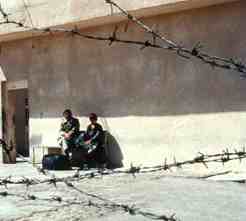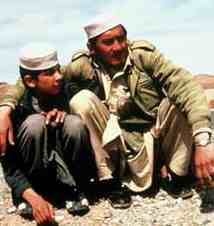IN THIS WORLD
reviewed by
ELBERT VENTURA
Elbert
Ventura is an arts and culture writer living in Washington,
D.C. His work has appeared in the New Republic and
Reverse Shot. This review first appeared in
Popmatters.
TRAIL OF TEARS
 Michael
Winterbottom's In This World begins in a dusty Afghan
refugee camp in Peshawar, Pakistan. It ends, 88 minutes later,
in a London mosque, where whispered prayers waft over the closing
credits. The brisk running time belies the tortuous odyssey
between those two points, a contradiction that gets at what
makes this devastating study of the refugee crisis at once valuable
and yet somehow compromised.
Michael
Winterbottom's In This World begins in a dusty Afghan
refugee camp in Peshawar, Pakistan. It ends, 88 minutes later,
in a London mosque, where whispered prayers waft over the closing
credits. The brisk running time belies the tortuous odyssey
between those two points, a contradiction that gets at what
makes this devastating study of the refugee crisis at once valuable
and yet somehow compromised.
Previously
titled The Silk Road, In This World is a fictionalized
account of the treacherous passage thousands of refugees from
Central Asia take to find a better life in the West. Dispassionate
narration sets the stage: the movie opens at the Peshawar camp,
to where Afghans began flocking in the 1980s following the Soviet
invasion of Afghanistan, and which has been filling up again
in the wake of the U.S. military campaign there following the
September 11 attacks.
It
doesn't take long for a narrative to take shape. Jamal, an orphan
teenager, and Enayat, a 30ish man with a child's face, prepare
to leave the camp for London, where life as illegal migrant
workers awaits. For the next few months, the two live in the
shadows, forever huddled in the backs of trucks, in back rooms
and alleys, and, most ominously, in the dark confines of a shipping
container. As they traverse two continents, the movie tracks
their progress on a computer-generated map, complete with animated
arrows and a voiceover dispensing background information. 
The
omniscient viewpoint suggests a documentarian's approach, an
impression only encouraged by Winterbottom's vérité
style. Shot on backroads, at border crossings, and in teeming
urban jungles, this is a bracing specimen of guerrilla filmmaking.
The movie was literally made on the run: accompanied by a skeleton
crew and armed with a digital video camera, Winterbottom followed
his leads as they reenacted with scary accuracy the trip from
Pakistan to London. He claims that no dialogue was scripted,
and that the narrative grew out of the stories relayed to them
by the people they encountered. Only illegal and dangerous events,
such as the harrowing crossing into Turkey, with its night-vision
footage and trigger-happy border guards, were staged. For the
rest, the director says he tried to create situations "where
people didn't have to act" (Village Voice, 24
September 2003).
No
less compelling than Winterbottom's working methods is the project's
genesis. A stirring work of advocacy, the movie came out of
Winterbottom's frustration with the emergent strain of xenophobia
in Europe. Aspiring to be emblematic, it's nothing less
than the immigrant myth for a new century and the New Europe.
The movie's activism gives it an urgency that the times only
magnify; at its best, In This World feels like a stirring
antidote to the parochial mood of the moment.
 The
film fits neatly into Winterbottom's eclectic canon. One of
Britain's most protean filmmakers, he can also claim to be one
of the world's most prolific. He has made a dozen features since
1995, an output that, while not quite Fassbinderian, certainly
qualifies him as one of contemporary cinema's more restless
creatures. (He may be the British Soderbergh, flitting back
and forth between intelligent crowd-pleasers and artistic doodles
with relative ease.) In This World is the starkest manifestation
of his humanism to date. The closest thing to it that he's done
is Welcome to Sarajevo, a war drama that overcame its
Hollywood cast and flashy style to create a moving portrait
of the Balkan mess.
The
film fits neatly into Winterbottom's eclectic canon. One of
Britain's most protean filmmakers, he can also claim to be one
of the world's most prolific. He has made a dozen features since
1995, an output that, while not quite Fassbinderian, certainly
qualifies him as one of contemporary cinema's more restless
creatures. (He may be the British Soderbergh, flitting back
and forth between intelligent crowd-pleasers and artistic doodles
with relative ease.) In This World is the starkest manifestation
of his humanism to date. The closest thing to it that he's done
is Welcome to Sarajevo, a war drama that overcame its
Hollywood cast and flashy style to create a moving portrait
of the Balkan mess.
Less
polished than that movie, In This World has the feel
of a downscaled epic. Despite the 'Scope dimensions of the film
transfer, the smudgy digital video look undercuts the baleful
poetry of the landscapes. Far from betraying Winterbottom's
vision, however, digital video at least makes it possible. Much
maligned for its sensual failings, digital video here lives
up to its promise of immediacy and portability. Like last year's
Inuit saga, The Fast Runner, In This World would simply
not exist without it.
Having
shot his last movie, 24 Hour Party People, on digital,
Winterbottom seems to have developed a fondness for the medium's
possibilities. His newfound enthusiasm calls to mind Abbas Kiarostami,
the Iranian filmmaker whose most recent pictures, Ten and ABC
Africa, were shot on DV as well. As others have pointed out,
the similarities don't end there. The use of non-actors, the
merging of narrative and non fiction, and the abiding compassion
also encourage the comparison. Like Kiarostami's movies, In
This World prompts questions about process: what is real
and what is staged? What lines are improvised and which are
coached?
Eschewing
the long takes of Iranian cinema, In This World appears
pieced together, perhaps a function of its ragtag roots. The
quick cuts and reliance on montage make the movie seem unfortunately
truncated. The effect is particularly jarring in the first half,
when Jamal and Enayat seemingly zip through Pakistan, Iran,
and Turkey. His heart may be in the right place, but Winterbottom
is a born showman -- he lacks the rigor and patience to convey
tedium and the passage of time.
That
failure to trust the audience rears its head in other places.
Dario Marinelli's intrusive score insists on leading you by
the hand, while some turns of plot, no doubt based on real events,
are played up for maximum drama. Winterbottom fails to realize
that nothing needs to be played up: the subject is drama enough.
His cinematic flourishes -- a lovely fast motion sequence straight
out of his own Wonderland, a reverse tracking shot
of Jamal as he runs toward the camera -- are especially false
alongside the movie's unadorned patches. Winterbottom says that
he never meant the movie to be anything but fiction, thus excusing
the movie's lapses into trendy style. It's a disingenuous claim,
considering the movie's canny deployment of documentary tropes.
For
all its flaws, In This World is not a failure -- far
from it. The whiff of audience supplication notwithstanding,
the movie has cumulative power. A climactic Sebastiao Salgado-esque
montage of the children left behind in the Peshawar camp packs
a wallop. Even more shattering is Jamal's last line, a touching
utterance that deepens the prosaic title unexpectedly. The closing
passages, in their stoicism and understatement, impart an unlikely
but welcome quality: grace.
While
In This World's missteps might indicate a lack of discipline,
they also account for its potency as reportage. Attempting to
put a human face on the refugee crisis, Winterbottom puts a
premium on legibility. He wants his vision to be accessible.
One can hardly begrudge him that objective. Devoting 88 minutes
to one of the world's gravest humanitarian crises seems too
stingy, but that, and the movie's other compromises, are comprehensible.
Winterbottom wants to get people into those seats; he wants
to change minds and lives. That touching faith in the power
of cinema ultimately redeems his big-hearted, imperfect movie.
In
This World won
the coveted Best Film award at the 2003 Berlin Film Festival.